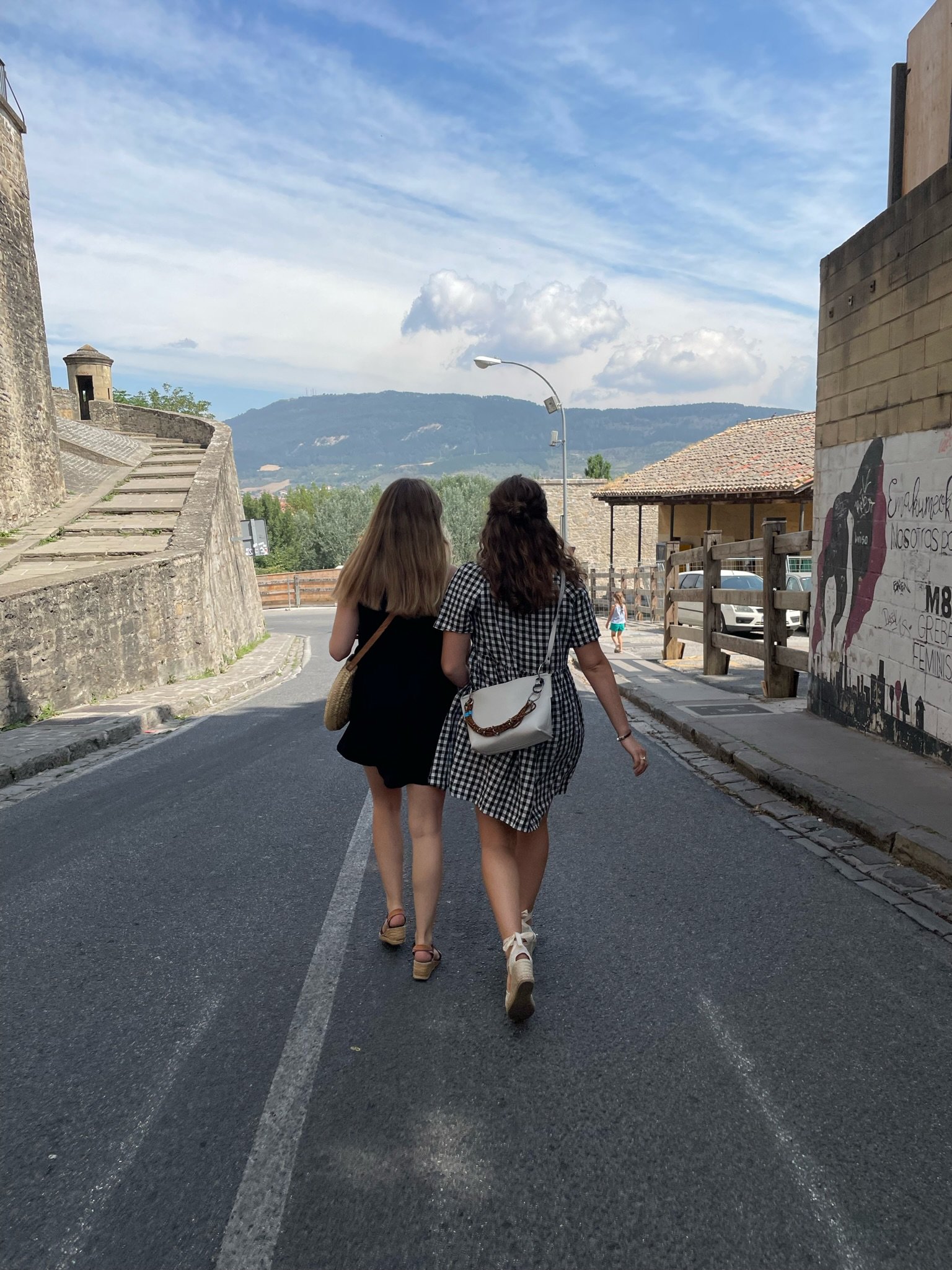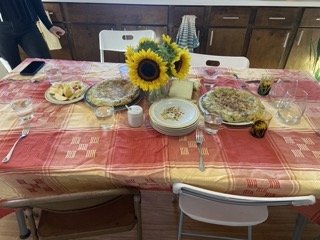Smoked: Reflections from a vegetarian in Spain
This is la Plaza del Castillo in Pamplona, Spain, on one of the 100+º days this June. Photo source: Amalia Herren-Lage
I have arrived in Spain this summer full knowing what to expect when it comes to food. In this country, this other home of mine, I stay with my aunt and uncle and their two daughters in Pamplona. They eat meat, lots of meat. In fact, Spaniards eat more meat than any other Europeans.
Eating meat at their table will be shock to my system in more than one way. Over the last two years I have lived with a vegetarian friend and eaten an almost exclusively plant-based diet, save for my love of cheese. I eat a lot of lentils, without chorizo. I choose the vegetarian option at restaurants. I even eat tofu (though I don’t like to talk about it). At this point, meat has become hard for my body to digest. Other aspects of a meat-based diet make me uncomfortable, too.
On this day the temperatures were within the range of a normal sunny day in June in Pamplona. My cousin Julia and I take advantage of the weather to walk the former perimeter of the city. (Photo source: Amalia Herren-Lage)
I know how eating meat affects the climate. Animal agriculture is responsible for between 14.5 percent and 28 percent of total greenhouse gas emissions, and some experts believe it’s even higher. Raising meat on an industrial scale is also water-intensive because of the need to water and grow the crops required to feed so many animals. And clearing land for grazing is a leading global driver of deforestation.
Here in Spain, I console myself with the fact that my uncle shops local. The meat we eat at home is raised within 20 miles of where we buy it. On Saturday mornings at 8 am he goes to the market down the street, grocery trolley in tow. Some mornings the rest of the family joins him, though not until later because we like to sleep in.
On these trips, we explore the village-like market, wandering among stalls, which are set up like miniature houses in a tiny town. We load the cart with meat, cheese, and piles of fruit and vegetables. I am a fanatic for saturn peaches, a stone-fruit variety I rarely find in the US, so we always get extra. We top it all off with fresh flowers from my aunt’s favorite florist.
So I don’t eat meat—except for now, when I am in Spain and staying with family. I am their long-term guest and they are feeding and housing me at no cost to myself. I don’t want to disrupt their lives any further by also requesting a complete change in their eating habits.
But this summer is different.
One morning I step onto the terrace, still in my pajamas. It’s late June and today is my birthday. I smell smoke. Not cigarette smoke, which I am used to in this country, but wood smoke.
My uncle’s terrace faces an enclosed space ringed by apartment buildings. There isn’t much of a view—just the stripes made by clotheslines and the sky, which today bears the gray smudge of wildfires.
I have spent nearly every summer of my life in Spain and am not much surprised by its weather or climate anymore. Pamplona is rainy, usually several degrees cooler than Madrid, a four hour drive to the south. Galicia, all the way to the west in the corner above Portugal, is humid, green, and stays light late into the evening. Madrid is always hot, and dry. Nobody has air conditioning but everybody has wooden shades, which they unfurl over their windows to block the afternoon sun.
Adela shared these photos with me after she came back to Pamplona from Allóz, where she lives most of the summer. Image source: Adela González Díez
This summer Madrid is even hotter, hovering around 40 degrees Celsius (104 degrees Fahrenheit) for more than a week straight .On the scrolling pharmacy sign boards in Pamplona it says, June 22, 13:00, 42ºC. To borrow a phrase we grew so tired of hearing in 2020, it’s unprecedented.
Growing up in Vermont and attending college in Maine I am accustomed to hearing about wildfires but they’ve always been a distant threat, more of a Southwest or West Coast phenomenon. My friends who went to school in California occasionally wore masks on campus long before the pandemic because of the dangerous air quality. In 2018, a few even got an extra long Thanksgiving break because it was too dangerous to be outside.
Where I live in central Vermont we shop organic, use solar panels, and drive electric cars, but it’s more of an intellectual commitment to sustainability than a response to changes in our world. That is to say, I have self-identified as an environmentalist since elementary school, but mostly it’s just that—a label I’ve given myself.
This past week in Pamplona is the first time I’ve heard my relatives openly discuss climate change. Before this, when my brother and I talked about global warming, relatives showed mild interest, as in, “oh so that’s what they’re learning in American schools.” Now this problem is no longer an intellectual exercise. My relatives can link global warming to the burning up of Navarra, the very town they live in. They can see the smoke streaming across the grain fields and wafting onto the terrace where I stand in my pajamas.
“This is the first time I feel fear in the immediate sense, the first time my skin is physically crawling with the danger of the nearness of climate-change.”
This is the first time I feel fear in the immediate sense, the first time my skin is physically crawling with the danger of the nearness of climate-change. It's the first time I have seen my family afraid, too.
My cousin Julia has made me a yogurt birthday cake and set up balloons numbered “23” at the table. Does she know where the fires are? She tells me she’s been looking at photos on Twitter, worried they might reach the famous castle in the nearby town of Olite. Our aunt Adela lives on the shores of a reservoir in the summer that is surrounded by fields of grain. We send her a WhatsApp message and she gets right back to us and tells us she has made it through the fires safely.
Each morning my uncle brings in three newspapers: one local and two national. The Diario de Navarra is filled with stories about wildfires from the last month: Wildfire in Castellón, Ezkaba wildfire, Meteorological report: Navarra at extreme risk of wildfires. Watching the nightly news we are bombarded with images of burning fields and cars making their way along roads surrounded by flames. I keep thinking, “it looks like California.” I keep thinking, “Adela is so lucky she made it out in time.”
My aunt Adela and me, on my birthday after she survived nearby wildfires and made it back to the city. The clock behind us counts down the days to San Fermín, the city’s patron Saint Day. (Photo source: Amalia Herren-Lage)
In the weeks after my birthday my family and I discuss the fires multiple times a day, in a rhythmic loop: “Did you hear about the new fire?” “I can’t believe it, I can’t believe it.” But not once do we discuss the role diet plays in global warming.
This was a summer of fighting the cognitive dissonance between my values and my behavior, and of reminding my body that it knows how to break down and digest meat despite the physical discomfort it brings me. In December 2021, Plant Based News published a story about meat-consumption in Spain, detailing the first public effort on behalf of a government official to encourage people to eat less meat for environmental reasons.
“The restaurant owner did not seem to understand what vegetarian meant. Could she eat pork? No? Fish? NO?!”
I did not need to read this article to know that these efforts would be poorly received. In Spain this isn’t an issue that can be sorted into “liberal” and “conservative.” Everyone eats meat, and everyone is going to resist the message that we need to eat less of it.
The same article finds that people in Spain generally attribute climate change to the greenhouse gasses emitted by vehicles. I can attest to this. So whether because it threatens masculinity, as some suggest, or is due to a lack of imagination, I don’t see meat disappearing from family meals any time soon. And yet.
When I’m home in Vermont and craving Spanish food, I cook the cultural classic that comes closest to being plant-based: the tortilla de patata, made of potatoes and local eggs, pictured here. (Photo source: Amalia Herren-Lage)
I make the decision to invite my friend, Ashka, to join us. She has always been a vegetarian and we struggle to find meat-free options on a menu. Salads automatically come with tuna. Everything, and I mean everything, has jamón on it, even the dishes that appear to be vegetarian. At my grandfather’s birthday party the restaurant owner did not seem to understand what vegetarian meant. Could she eat pork? No? Fish? NO?!
But Pamplona, my beloved city, has a tradition of dining on pintxos, which are small, elaborate, well-crafted dishes for one. Most of them include—you guessed it—jamón. But at a popular place called Bar Monasterio, we find a falafel-based dish that blows us all away, even my life-long carnivorous uncle. Pablo will not become a vegetarian any time soon but that night he proved himself capable of enjoying a dish made to be meatless.
Some might think this isn’t even worth mentioning—this tiny, incremental sign of progress. And in the face of all the changes we need to make to slow the rate of global warming it might not be. Yet, policy and culture can act on each other, in hopeful or devastating ways.
Before I knew what renewable energy was I grew accustomed to seeing long ridges of wind turbines in Spain. In fact, Spain is nearing the 50 percent renewable mark when it comes to the country’s total energy consumption. So the idea of fighting climate change is not unreasonable to many citizens, but giving up meat is—for now.
Amalia Herren-Lage is a Stone Pier Press News Fellow based in Middlebury, VT.













